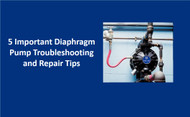5 Important Diaphragm Pump Troubleshooting and Repair Tips
Posted by David Cannon on 21st Feb 2021

The diaphragm pumps are used in several industrial applications for transferring fluids. These pumps feature simple designs, and are easy to operate, which makes them popular. Having said that, all these properties donât make these pumps any failproof. They also fail like other industrial pumps. These pumps need to be installed and maintained properly to ensure their appropriate performance. If you are facing any problems with your diaphragm pumps during the usage or installation, you can troubleshoot the problems and repair them sooner. This post offers tips on diaphragm pump troubleshooting and repair.
Top 5 Tips for Troubleshooting and Repairing Diaphragm Pumps
You would agree that the pump can only be repaired once you identify the problem. You can perform troubleshooting in the following ways:
- Extreme Low or No Pressure: At times, you may experience low or no pressure in the pump. These situations may be caused by insufficient RPM speed. If the RPM speed goes below the recommended speed then pressure problems may arise. In this situation, it becomes important to reset the revolutions per second of the pump to the recommended value. If the pressure becomes equal to zero or remains low even after setting the RPM, then there may be issues with the component â nozzle. The nozzle may wear or tear after years of use. If you observe any of these signs during the inspection then it is better to replace the nozzle or repair an existing pump depending on its condition.
- Slow Water Priming: This is the most common problem faced by users. The pump may not prime or draw water easily. There can be three main reasons for the same:
- Air Suction: Many times, the pipe or its fittings may start sucking air, which pushes the water backward. This causes a delay in pumping and suction mostly happens due to loosened fittings. Thus, the entire suction line must be inspected to ensure the fittings are fastened properly and securely.
- A Regulator in Pressure Mode: Often, you do not pay attention to the regulator then it may slip into the pressure mode. This may slow down water pumping. To rectify it, always change the regulator in the âby-passâ mode.
- Excessive Vibrations: This is one of the most commonly visible issues in the diaphragm pump. The pump may show excessive vibration or pulsation at certain hours of performance. This may be due to increased pulsation of the dampener. It is recommended to check the pulsation after every 50 hours of performance and reset pressure to correct the vibration.
- Backpressure, Increased Cavitation, and Accelerated Maintenance Times: Fluid line restrictions are one of the key reasons for increased backpressure, cavitation, and maintenance times. If you wish to conduct diaphragm pump repair by self here are some tips that will help you identify the fluid line restrictions and rectify them in time.
- Check if any valves are partially or fully closed: If any of these is found then ensure that the valves are kept opened.
- Check clogging or kinks in the line: For this, you need to follow the flow of fluid through various areas of the pipeline. If you identify clogging or kinking at any point then it needs to be eliminated immediately.
- Check if the hoses of the right length are used: If you feel that longer hoses are better, then perhaps that may not be the case. It is important to use hoses of the right length.
- Leaking: Like any other industrial pump, the diaphragm pumps are also vulnerable to leaking. As a diaphragm pump troubleshooting, it is always recommended to check for any small and major leaks throughout the equipment. If leaking is observed, this is how you can proceed:
- Ensure the components are in good working condition and not worn or torn beyond repair.
- Replace the pump components whenever necessary with original components.
- Ensure all fittings are fastened properly throughout the line.
- Torque the pump to specifications described in the pump manual.
âHow to repair a diaphragm pump?â has been a popular query on Google for several years now. Although the diaphragm pump troubleshooting tips in this post will help you identify the problems, it is important to get the pump repaired by experts. Also, to avoid failure, it is necessary to source these diaphragm pumps from trusted suppliers. Cannon Water Technology is one of the leading providers of diaphragm pumps in the US and it stocks pumps from brands like Knight Equipment, LMI pumps, and Pulsafeeder, as well as provides several accessories for the pumps. The experts at the company work with the clientsâ right from the inquiry to the implementation phase to simplify the whole ordering and implementation process.
